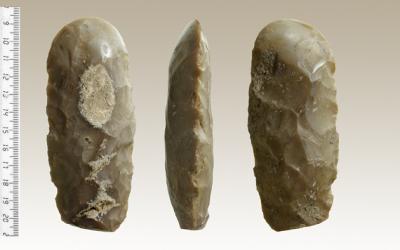And clear cutting forests is what ancient man did too.
During the Neolithic Age, 10,000 B.C., early man changed from being hunter-gatherers to farmers - ancient scientists told that the food supply was running low and listening to calls for mitigation and rationing instead invented domesticated livestock and agriculture. As a result, we got larger, permanent settlements with a variety of domesticated animals and plant life. and that transition brought about significant changes in terms of culture, economics, architecture, etc,
Dr. Ran Barkai, archaeologist at Tel Aviv University, says he can make a direct connection between the development of a modern society and the development of logging.
"Intensive woodworking and tree-felling was a phenomenon that only appeared with the onset of the major changes in human life, including the transition to agriculture and permanent villages," says Barkai.
Prior to the Neolithic period, there is no evidence of tools that were powerful enough to cut and carve wood, let alone fell trees. But new archaeological evidence suggests that as the Neolithic age progressed, sophisticated carpentry developed alongside agriculture.

Polished axe from the Neolithic Period. Credit: American Friends of Tel Aviv University. Link: Science Codex
Evolution of axes
Axes are still part of our cultural lexicon even today, though most people have never held one much less used it.(1) Barkai and the team have unearthed(2) evidence that increasing sophistication in terms of carpentry tools corresponds with increased agriculture and permanent settlements. The early part of the Neolithic age is commonly divided into two distinct parts — Pre-Pottery Neolithic A (PPNA) and Pre-Pottery Neolithic B (PPNB), where agriculture and domesticated plants and animals appear. The second part is a watershed moment in human history, thus the distinction. These changes can be tracked in the woodworking tools which belong to each period, says Barkai.
During PPNA, humans were still gatherers but lived increasingly in more permanent settlements for the first time, he says. Axes associated with this period are small and suitable for light carpentry but not for felling trees or massive woodworking tasks. In PPNB, those tools became much larger and heavier, formed by a technique called polishing, and they were used to cut down trees and complete various building projects.
"We can document step by step the transition from the absence of woodworking tools, to delicate woodworking tools, to heavier woodworking tools," Barkai says, and this follows the "actual transition from the hunter-gatherer lifestyle to agriculture."
He also identifies a trial-and-error phase during which humans tried to create an axe strong enough to undertake larger woodworking tasks. Eventually, they succeeded in creating a massive ground stone axe in PPNB. Whether the transition to an agricultural society led to the development of major carpentry tools or vice versa is still anthropological speculation, a circular argument, butt the parallel changes led to a revolution in lifestyle.
Beyond the change from a hunter-gatherer to an agricultural economy, a new form of architecture also emerged. Not only did people begin to live in permanent villages, but the buildings in which they lived literally took a different shape. The round and oval structures of earlier domiciles were replaced by rectangular structures in PPNB, explains Barkai. "Evidence tells that us that for each home, approximately 10 wooden beams were needed. Prior to this, there were no homes with wooden beams." In addition, humans began to produce limestone-based plaster floors for their homes — which also represented a growing use of wood, since plaster is manufactured by heating limestone.
These architectural developments, along with building pens and fences for domesticated animals, also necessitated the felling of trees in large quantities.
NOTES:
(1) See Ash in "Army of Darkness" or any "Evil Dead" movie. Using an axe is meant to be deliberately shocking because axes are ingrained in our psyches as tools, not weapons.
(2) Yes, that was intentional.




Comments